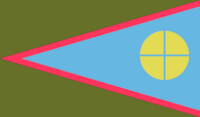Adlátát Tarrán
This article is incomplete because it is pending further input from participants, or it is a work-in-progress by one author. Please comment on this article's talk page to share your input, comments and questions. Note: To contribute to this article, you may need to seek help from the author(s) of this page. |
| Liberation Force of Bahía Alta | |
|---|---|
| Adlátát Tarrán ulm Soixì | |
 The flag of Adlátát Tarrán, which is also the flag of the Ipópopó Tribe. | |
| Leader | Vétoill Lhazarth Clehem Ernuchalj |
| Foundation | ? |
| Dissolved | 2014 |
| Country | Narsora Kûlmálm (self-declared) |
| Motives |
|
| Headquarters | Yársalzu, Narsora |
| Ideology |
|
| Major actions | |
| Notable attacks | |
| Status | Inactive, militarily defeated in 2014. |
| Size | 1000-5,453 (estimated between 2010-2014) |
| Annual revenue | NRD$200,000 |
| Means of revenue | Donations from local Ipópopó, extortion, foreign sources |
The Adlátát Tarrán (literally: Liberation Force) was a separatist group active in the Republic of Narsora from sometime between the early 2000's to 2014. The main goal of the group was to establish a sovereign homeland for the Ipópopó indigenous people on the island of Bahía Alta, the ancestral homeland of the peoples. They were officially defeated in October 2014, after a government military offensive.
History
In the late-1960's a political movement known as Ipópopó Pùrdútsat (Ipópopó First) was started by the local Ipópopó peoples on the island province of Bahía Alta, to protest the central government's plans to turn the island into a resort. When political options failed, this group turned to violence; in 1971, members of the movement kidnapped a group of construction workers in the capital of Ríarudu. During the ensuing rescue mission by security forces, army paratroopers executed around 100 including those responsible and civilians alike.
This further galvanized many of the island's natives, leading to widespread support for the movement. In 1985, it's followers claimed responsibility for an attack that killed four police officers. Several of those involved were later captured or killed by security forces. Following a government crackdown in the early 1990's, the group in this incarnation seemingly became inactive.
On 8 November 2009, a group calling themselves the Adlátát Tarrán claimed responsibility for a bombing which left 32 people dead and 228 wounded. This new group threatened more violence unless the central government formally granted full sovereignty to Bahía Alta Island. They claimed responsibly for a 2010 attack on an army barracks station, which killed 12 service members.
After this incident, the government declared a state of emergency and authorized the armed forces to capture the members of this group.
Most of these militants had no proper military background, and were as a consequence, undisciplined and poorly trained. According to CRTN-3 journalist Cimoum Yéxách (the only journalist to ever obtain an interview with members of the group), many of them seemed as if they "didn't even know how to hold their firearms".
Major activities
Terrorism
Terrorism was the first major tactic used by the group to achieve it's goals, in addition to committing several high-profile attacks on the mainland, it also carried out many small scale attacks on Bahía Alta Island proper.
On September 10, 2010, a group of ATS militants attacked a resort in the town of Álkarz. According to witnesses, the assailants targeted Narsoran tourists and executed eight of them while allowing the foreigners to leave the hotel unharmed.
The ATS began by only targeting Narsorans of white ethnicity, but by 2013, began targeting any and all of those suspected of "being loyal" to the central government.
Economic subversion
The group also targeted economic resources like hotels, drinking establishments, banks and government buildings, in an attempt to destabilize the economy of the island.
Recruitment
Unlike it's predecessor organization, the Ipópopó Pùrdútsat, the ATS did not enjoy broad support of the Ipópopó peoples. Many considered their methods extreme, barbaric and unlikely to suede the government. They did, however, find some supportive to their cause in poorer areas of the province, mainly those further inland and away from the coast. It is believed these were peoples whom were distrusting of the government due to their current circumstances. Many supporters were also older and primarily men, as many young people saw the group as terrorists and their cause extremist.
Weapons and Armament
According to captured militants, the group reportedly obtained most of their armaments and weapons by stealing them from firearms stores. They were also known to steal the equipment from killed or captured government soldiers, and during the 2010 Tázatú barracks attack , managed to briefly enter the armory of the barracks and steal several military grade firearms including rifles, anti-tank missiles and hundreds of rounds of ammunition.
In late-2011, was discovered that the group were obtaining arms and other equipment from an unknown foreign source. As of 2019, neither the identity of that source nor the amount of equipment it supplied to the group has yet to be found.